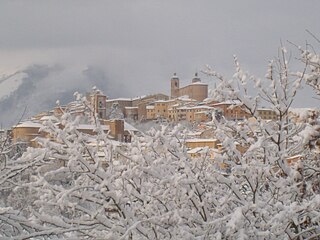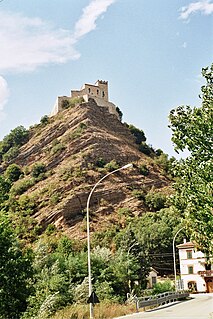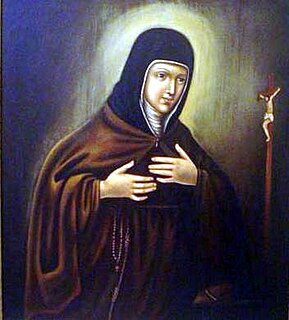Related Research Articles

Ottavio Farnese reigned as Duke of Parma and Piacenza from 1547 until his death and Duke of Castro from 1545 to 1547 and from 1553 until his death.

The Duchy of Spoleto was a Lombard territory founded about 570 in central Italy by the Lombard dux Faroald. Its capital was the city of Spoleto.

Odoardo Farnese was an Italian nobleman, the second son of Alessandro Farnese, Duke of Parma and Maria of Portugal, known for his patronage of the arts. He became a Cardinal of the Roman Catholic Church in 1591, and briefly acted as regent of the Duchy of Parma and Piacenza for his nephew Odoardo from 1622 to 1626.

Guy III of Spoleto was the margrave of Camerino from 880 and then duke of Spoleto and Camerino from 883. He was crowned king of Italy in 889 and emperor in 891. He died in 894 while fighting for control of the Italian Peninsula.

Camerino is a town in the province of Macerata, Marche, central-eastern Italy. It is located in the Apennines bordering Umbria, between the valleys of the rivers Potenza and Chienti, about 64 kilometres (40 mi) from Ancona.
Emilio Betti was an Italian jurist, Roman Law scholar, philosopher and theologian. He is best known for his contributions to hermeneutics, part of a broad interest in interpretation. As a legal theorist, Betti is close to interpretivism.

Duke of Camerino is a title of nobility, originally in Papal peerage. It was created on 1503 by Apostolic authority of Pope Alexander VI and cardinal council over the ancient Marquissate of Camerino, which was part of the Dukedom of Spoleto.

The University of Camerino is a university located in Camerino, Italy. It is the best university of Italy among those with fewer than 10,000 students, according to the Guida Censis Repubblica 2011 and 2012 ranking. It claims to have been founded in 1337 and was officially recognized by the Pope in 1723. It is organized into five faculties.

The Italian Archdiocese of Camerino-San Severino Marche is a Roman Catholic ecclesiastical territory, seated in Camerino, a city in the Province of Macerata, in the central Italian Marche region, in the Apennines. It is a suffragan of the Archdiocese of Fermo.

Saint Ansovinus was a bishop of Camerino, and is the patron saint of agriculture. His feast day is March 13.

Venantius of Camerino is the patron saint of Camerino, Italy and Raiano, Italy. Christian tradition holds that he was a 15-year-old who was tortured, and martyred by decapitation at Camerino during the persecutions of Decius. Martyred with him were 10 other Christians, including the priest Porphyrius, Venantius' tutor; and Leontius, bishop of Camerino.

The Da Varano was an Italian noble family who had an important role in the medieval and Renaissance history of central Italy, as rulers of Camerino and other lands in the Marche and Umbria.
Saints Severinus of Sanseverino and Victorinus of Camerino were brothers who were both bishops and hermits of the 6th century.
Theobald II was the Duke of Spoleto and Margrave of Camerino from 953. He was the son of Boniface II of Spoleto and Waldrada.

Camerino Z. Mendoza Municipality is a municipality in Veracruz, Mexico. It is located about 85 km from state capital Xalapa. It has a surface of 37.84 km2. It is located at 18°48′N97°11′W.In 1898 there is established the head-board of Necoxtla's Municipality, in Santa Rosa; for decree of 1910 in village of Santa Rosa, it rises up to the category of Villa. Santa Rosa Necoxtla, in 1930, is named Camerino Z. Mendoza. By decree of November 5, 1932, the Municipality of Santa Rosa Necoxtla, it is named Camerino Z. Mendoza; the decree of July 4, 1933 raises to the political category of city, the Villa of Camerino Z. Mendoza.

The Camerino Farnese is a Fresco cycle that emerged from the decision to paint the ceiling of the Camerino in Rome, before the summer of 1595. The Camerino is on the first, or principal, floor of the Palazzo Farnese, and measures slightly more than fifteen by thirty feet.

Olivuccio Ceccarello di Ciccarello was an Italian painter. Little is known of his life. He was a native of Camerino and was active from 1388 until his death. In 2002 works formerly attributed to an obscure painter named Carlo da Camerino were re-attributed to Olivuccio di Ciccarello as it had become clear Carlo da Camerino had never existed.

Camilla Battista da Varano O.S.C.,, from Camerino, Italy, was an Italian princess and a Poor Clare nun and abbess. She is venerated as a saint in the Catholic Church.

Giuliana Camerino was an Italian fashion designer who founded the Roberta di Camerino fashion house in Venice, the only major Italian fashion brand to be based in the historic seafaring and trading city. The label is principally known for its velvet handbags, though it has also produced womenswear and shoes. Giuliana Camerino has been credited with creating the concept of the status bag.

Edoardo Menichelli is a prelate of the Roman Catholic Church. He served as Archbishop of the Archdiocese of Ancona-Osimo from 2004 to 2017. Pope Francis made him a cardinal on 14 February 2015.
References
- Bryan, Michael (1886). Robert Edmund Graves (ed.). Dictionary of Painters and Engravers, Biographical and Critical. Vol. I: A-K. London: George Bell and Sons. p. 220.